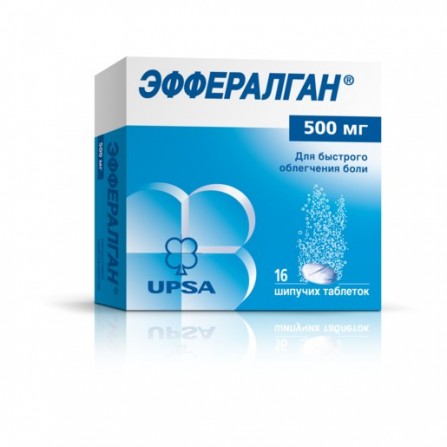Efferalgan effervescent pills 16 pcs
Condition: New product
995 Items
Rating:
Be the first to write a review!

More info
Active ingredients
Paracetamol
Release form
Pills
Composition
1 tablet: paracetamol 500 mg. Excipients: anhydrous citric acid - 1114.00 mg, sodium bicarbonate - 942.00 mg, sodium anhydrous carbonate - 332.00 mg, sorbitol - 300.00 mg, sodium saccharinate - 7.00 mg, sodium dokuzat - 0.227 mg, povidone - 1.287 mg, sodium benzoate - 60.606 mg ;
Pharmacological effect
Efferalgan contains paracetamol, which blocks COX-1 and -2 mainly in the central nervous system, affecting the centers of pain and thermoregulation. In inflammatory tissues, cellular peroxidases neutralize the effect of paracetamol on COX, which explains the almost complete absence of an anti-inflammatory effect. The absence of a blocking effect on the synthesis of PG in peripheral tissues determines the absence of a negative effect on the water-salt metabolism (Na + and water retention) and the gastrointestinal mucosa;
Pharmacokinetics
Absorption of paracetamol is complete and fast. The peak plasma concentration is reached in 30–60 min after administration. The distribution of paracetamol in the tissues occurs quickly. Achieved comparable concentrations of the drug in blood, saliva and plasma. Plasma protein binding is low, 10–25%. It penetrates the BBB.; Metabolism occurs in the liver, 80% reacts conjugation with glucuronic acid and sulfates with the formation of inactive metabolites; 17% undergoes hydroxylation with the formation of 8 active metabolites, which are conjugated with glutathione with the formation of already inactive metabolites. With a lack of glutathione, these metabolites can block the enzyme systems of the hepatocytes and cause their necrosis. CYP2E1 isoenzyme is also involved in the metabolism of the drug. T1 / 2 - 1-4 h. It is excreted by the kidneys as metabolites, mainly conjugates. Unchanged output is less than 5% .;
Indications
Pain syndrome of weak or moderate intensity: headache, toothache, migraine, neuralgia, muscle pain, lower back pain, pain in injuries and burns, sore throat, algomenorrhea; - Increased body temperature for colds and other infectious and inflammatory diseases;
Contraindications
Chronic alcoholism; - deficiency of glucose-6-phosphate dehydrogenase; - I and III trimesters of pregnancy; - lactation period (breastfeeding); - children's age up to 15 years (body weight less than 50 kg); - hypersensitivity to the components of the drug .;
Use during pregnancy and lactation
The drug is contraindicated in the first and third trimesters of pregnancy and during lactation (breastfeeding);
Dosage and administration
The tablet should be dissolved in a glass of water (200 ml) and drunk.; Assign inside 0.5-1 g (1-2 tab.) 2-3 times / day at intervals of at least 4 hours. The maximum single dose is 1 g (2 tab.), daily - 4 g (8 tab.). In patients with impaired liver or kidney function and elderly patients, the daily dose should be reduced, the interval between doses of the drug should be at least 8 hours; The duration of treatment (without consulting as a doctor) is no more than 5 days when used as an analgesic and 3 days as an antipyretic medication. ARISING .;
Side effects
Allergic reactions: seldom - skin rash, itching, hives, angioedema; From the alimentary system: rarely - nausea, vomiting; long-term use in high doses may have a hepatotoxic effect, irritation of the mucous membrane of the rectum, tenesmus. From the hematopoietic system: extremely rare - anemia, thrombocytopenia, leukopenia.; Others: long-term use in high doses may have a nephrotoxic effect in the recommended doses.; With the development of adverse reactions, it is necessary to stop using the drug and consult a doctor;
Overdose
Symptoms: pale skin, anorexia, nausea, vomiting; hepatonecrosis (severity of necrosis due to intoxication directly depends on the degree of overdose). Toxic effects in adults are possible after taking paracetamol at a dose of more than 10-15 g: an increase in liver transaminase activity, an increase in prothrombin time (12-48 hours after administration); A detailed clinical picture of liver damage occurs after 1-6 days. Rarely - fulminant development of liver failure, which may be complicated by renal failure (tubular necrosis) .; Treatment: in the first 6 hours after an overdose - gastric lavage, the introduction of SH-group donators and precursors of the synthesis of glutathione - methionine 8-9 hours after the overdose and N-acetylcysteine 12 hours. The need for additional therapeutic measures (further introduction of methionine / in the introduction of N-acetylcysteine) is determined by the concentration of paracetamol in the blood, as well as the time elapsed after its intake .;
Interaction with other drugs
Inductors of microsomal oxidation in the liver (phenytoin, ethanol, barbiturates, rifampicin, phenylbutazone, tricyclic antidepressants) increase the production of hydroxylated active metabolites of paracetamol, which makes it possible to develop severe intoxication with a small overdose of the drug. the risk of hepatotoxic action of paracetamol.; Paracetamol reduces the effectiveness of uricosuric drugs.; With simultaneous use of paracetamol ethane ol contributes to the development of acute pancreatitis .;
special instructions
With continued febrile syndrome with the use of paracetamol for more than 3 days, and pain syndrome for more than 5 days, consultation with a physician is required.; Distorts laboratory test results in quantitative determination of plasma uric acid content;; To avoid toxic liver damage, paracetamol should not be combined with the intake alcohol, as well as taking those prone to chronic alcohol consumption.; The risk of liver damage increases in patients with alcoholic hepatosis. SG drug application necessary to monitor patterns of peripheral blood and functional state of the liver;. Efferalgan contains 412.4 mg of sodium in 1 tablet that must be considered by patients on a strict low-salt diet. The pills contain sorbitol, so the drug should not be used with fructose intolerance, low absorption of glucose and galactose, isomaltase deficiency .;


